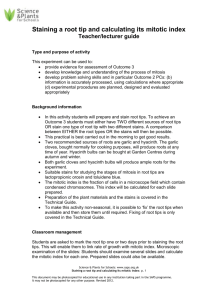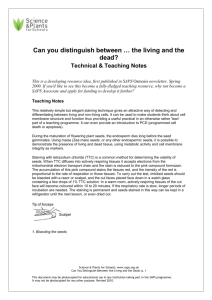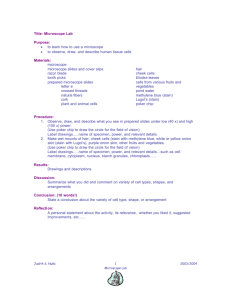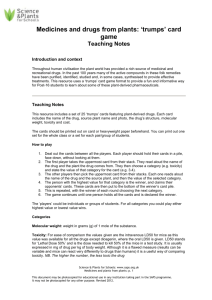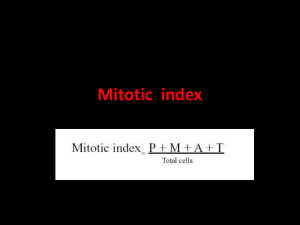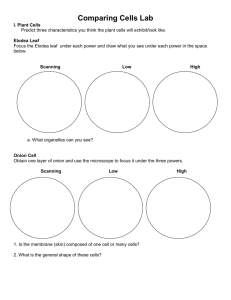Staining a root tip and calculating its mitotic index Student Guide
advertisement
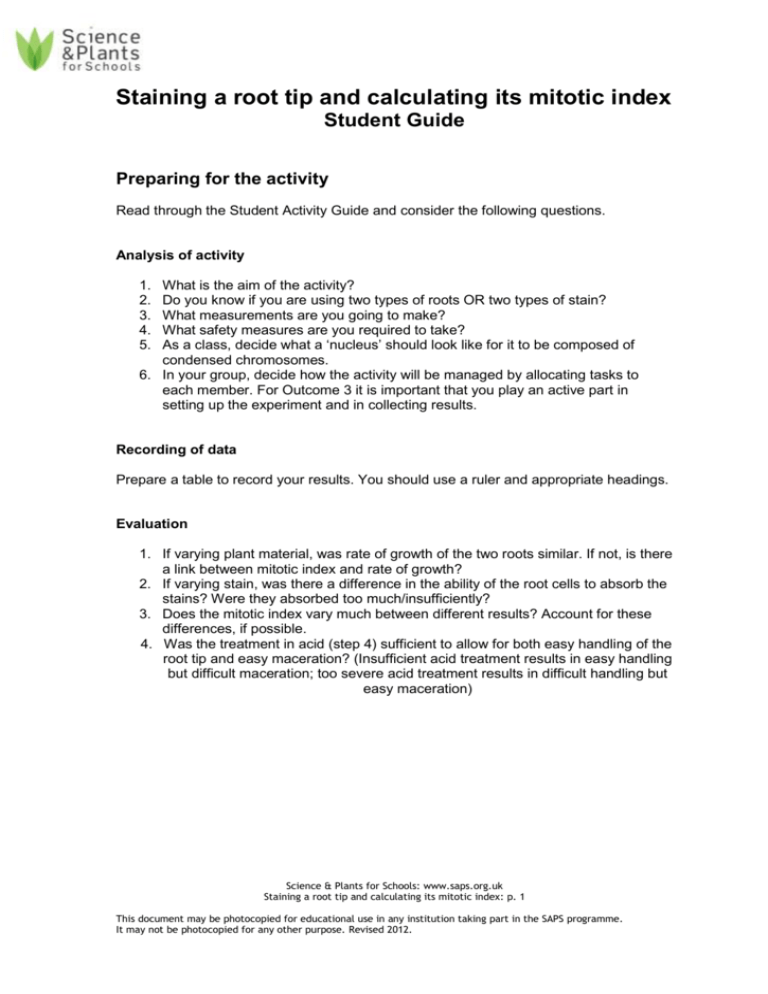
Staining a root tip and calculating its mitotic index Student Guide Preparing for the activity Read through the Student Activity Guide and consider the following questions. Analysis of activity 1. 2. 3. 4. 5. What is the aim of the activity? Do you know if you are using two types of roots OR two types of stain? What measurements are you going to make? What safety measures are you required to take? As a class, decide what a ‘nucleus’ should look like for it to be composed of condensed chromosomes. 6. In your group, decide how the activity will be managed by allocating tasks to each member. For Outcome 3 it is important that you play an active part in setting up the experiment and in collecting results. Recording of data Prepare a table to record your results. You should use a ruler and appropriate headings. Evaluation 1. If varying plant material, was rate of growth of the two roots similar. If not, is there a link between mitotic index and rate of growth? 2. If varying stain, was there a difference in the ability of the root cells to absorb the stains? Were they absorbed too much/insufficiently? 3. Does the mitotic index vary much between different results? Account for these differences, if possible. 4. Was the treatment in acid (step 4) sufficient to allow for both easy handling of the root tip and easy maceration? (Insufficient acid treatment results in easy handling but difficult maceration; too severe acid treatment results in difficult handling but easy maceration) Science & Plants for Schools: www.saps.org.uk Staining a root tip and calculating its mitotic index: p. 1 This document may be photocopied for educational use in any institution taking part in the SAPS programme. It may not be photocopied for any other purpose. Revised 2012. Student activity guide Introduction You are going to stain root tips and examine them for signs of cells dividing by mitosis. The chromosomes inside the nuclei of such cells condense and become visible. You should know what condensed chromosomes look like and how they move about inside a cell when undergoing mitosis. Equipment and materials Materials required by each student/group: gloves and eye protection compound microscope ( x100 - x400 magnification) small beaker of 1 M hydrochloric acid (2 will be required if plant material is being investigated) small beaker of water and dropper microscope slides coverslips fine forceps dissecting needle scissors soft tissue paper ruler fine thread dropping bottle of lactopropionic orcein AND/OR (see below) dropping bottle of toluidine blue garlic clove with suitable roots AND/OR (see below) hyacinth bulb with suitable roots Materials to be shared: water bath at 60°C marker pen timer dropping bottle of 50% glycerol dropping bottle of 70% ethanol lens tissue CARE! Wear gloves and eye protection whilst carrying out this experiment. Avoid skin contact with the stain(s) and avoid breathing in the fumes of the stain, lactopropionic orcein, if used. Science & Plants for Schools: www.saps.org.uk Staining a root tip and calculating its mitotic index: p. 2 This document may be photocopied for educational use in any institution taking part in the SAPS programme. It may not be photocopied for any other purpose. Revised 2012. Instructions Either two types of roots OR two different stains will have been prepared. Find out what is available. 1. One or two days before staining the root tips, remove the plant material carefully from the water and blot dry gently. Use a permanent marker pen to mark a small dot about 2 mm from the end of some root tips. Replace the plant carefully in the water. 2. After one to two days, remove the plant material and use the thread and ruler to measure how much the root tips have grown since marked. 3. Preheat about 10 cm3 of 1 M hydrochloric acid in a small beaker to 60°C using a waterbath. Meanwhile, use a lens tissue and alcohol to clean microscope slides and coverslips. 4. Using scissors remove the last 2 mm from several young vigorously growing root tips. Place them in the preheated acid and return to the waterbath for 4-5 minutes. 5. Gently transfer each root tip to a clean microscope slide containing a large drop of water. 6. Gently blot dry with a piece of soft tissue. It is important to remove as much water as possible. 7. Using a dissection needle, thoroughly macerate the root tip and spread over an area equivalent to the size of a 5p coin. (alternatively you could place another microscope slide at right angles to the original slide to form a cross, and squash the tip between the two slides. This method will provide two samples for staining.) 8. You are now ready to apply the stain. If using toluidine blue - add one drop to the macerated root tip and IMMEDIATELY cover with a coverslip, invert the slide and blot firmly several times on a wad of tissues. If using lactopropionic orcein - add one drop to the macerated root tip and leave for 3-4 minutes. To speed up absorption of the stain, warm the slide gently by holding it 30-40 cm above a yellow bunsen flame (if your hand becomes uncomfortable you are heating the slide too much). Cover with a coverslip, invert the slide and blot firmly several times on a wad of tissues. 9. View under a microscope, x40 - x100 magnification initially. Scan the slide to locate the region of mitosis. Science & Plants for Schools: www.saps.org.uk Staining a root tip and calculating its mitotic index: p. 3 This document may be photocopied for educational use in any institution taking part in the SAPS programme. It may not be photocopied for any other purpose. Revised 2012. 10. View this area at a higher magnification (x400 should be sufficient) and count: (i) the total number of cells in the microscope field (ii) the number of cells with condensed chromosomes which are going through any of the four stages of mitosis. You will have to decide where your cut-off point is when considering if cells in prophase and telophase contain condensed chromosomes (consult textbooks). 11. Repeat steps 9 and 10 for the various microscope slides prepared. If you want to prevent the slides from drying out, mount them in 50% glycerol. 12. Calculate the mitotic index for each slide examined (the mitotic index is the fraction or percentage of cells containing condensed chromosomes). 13. Draw a table with suitable headings summarising your results. 14. Compare your results with those of other groups. Science & Plants for Schools: www.saps.org.uk Staining a root tip and calculating its mitotic index: p. 4 This document may be photocopied for educational use in any institution taking part in the SAPS programme. It may not be photocopied for any other purpose. Revised 2012.
